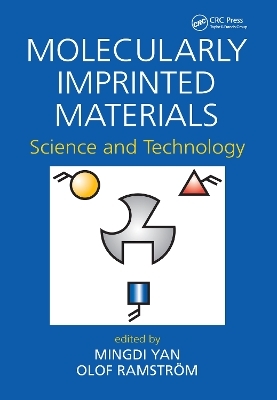
Molecularly Imprinted Materials
Crc Press Inc (Verlag)
978-0-8247-5353-5 (ISBN)
Providing an up-to-date overview of the field, this reference presents extensive discussions on a wide range of approaches for molecular imprinting written by pioneering experts on the subject. Molecularly Imprinted Materials: Science and Technology offers experimental protocols that exemplify specific techniques, as well as detailed surveys on molecular imprinting research and applications.
Provides a comprehensive tutorial for those who wish to learn basic techniques and make new contributions to the field, as well as in-depth discussions, guidelines, and experimental protocols to help beginners gain a jump-start in the field of molecular imprinting
The book examines the recent evolution of the technology, offering step-by-step instruction on methods to design and optimize molecularly imprinted polymers and suggestions, recommendations, and troubleshooting strategies for alternative approaches and improvements discussed in the text.
about the editors...
MINGDI YAN is Associate Professor, Department of Chemistry, Portland State University, Oregon. After serving as a senior research scientist at Ikonos Corporation, Portland, Oregon, she joined the Portland State University faculty and now leads a research group in organic and polymeric materials science. She received the B.S. degree in polymer physics from the University of Science and Technology, China, and the Ph.D. degree in organic chemistry from the University of Oregon.
OLOF RAMSTRÖM is Associate Professor, Royal Institute of Technology, Stockholm, Sweden. After serving with Professor Jean-Marie Lehn at Université Louis Pasteur, Strasbourg, France, he joined the Royal Institute of Technology and is now leading a group specializing in supramolecular chemistry and molecular recognition. He received the M.Sc. degree in chemical engineering and the Ph.D. degree in bioorganic chemistry/applied biochemistry from Lund Institute of Technology/Lund University, Sweden.
Mingdi Yan
Molecular Imprinting - An Introduction. A Brief History of the "New Era" of Molecular Imprinting. The Non-Covalent Approach. The covalent and other stoichiometric approaches. The Semi-covalent Approach. The Use of Metal Coordination for Controlling the Microenvironment of Imprinted Polymers. Synthesis and Selection of Functional and Structural Monomers. Combinatorial Approaches to Molecular Imprinting. Surface Imprinting. Scaffold Imprinting. Imprinting in Inorganic Matrices. Post Modification of Imprinted Polymers. Molecular Imprinting Using Hybrid Materials as Host Matrices. Thermodynamic Considerations and the Use of Molecular Modeling as a Tool for Predicting MIP Performances. Selectivity in Molecularly Imprinted Matrices Binding Isotherms. Molecularly Imprinted Polymer Beads. Molecularly Imprinted Polymer Films and Membranes. Micromonoliths and Microfabricated Molecularly Imprinted Polymers. Chromatographic Techniques. Capillary Electrophoresis. Metal Ion selective Molecularly Imprinted Materials. Solid Phase Extraction and Byproduct Removal. Applications of Molecularly Imprinted Materials as Enzyme Mimics. Application of MIPs as Antibody Mimics in Immunoassays. Molecularly Imprinted Polymers as Recognition Elements in Sensors: Mass and Electrochemical Sensors. Molecularly Imprinted Polymers as Recognition Elements in Optical Sensors
| Erscheint lt. Verlag | 30.11.2004 |
|---|---|
| Zusatzinfo | 19 Halftones, black and white |
| Verlagsort | Bosa Roca |
| Sprache | englisch |
| Maße | 178 x 254 mm |
| Gewicht | 1474 g |
| Themenwelt | Naturwissenschaften ► Chemie ► Organische Chemie |
| ISBN-10 | 0-8247-5353-4 / 0824753534 |
| ISBN-13 | 978-0-8247-5353-5 / 9780824753535 |
| Zustand | Neuware |
| Haben Sie eine Frage zum Produkt? |
aus dem Bereich


